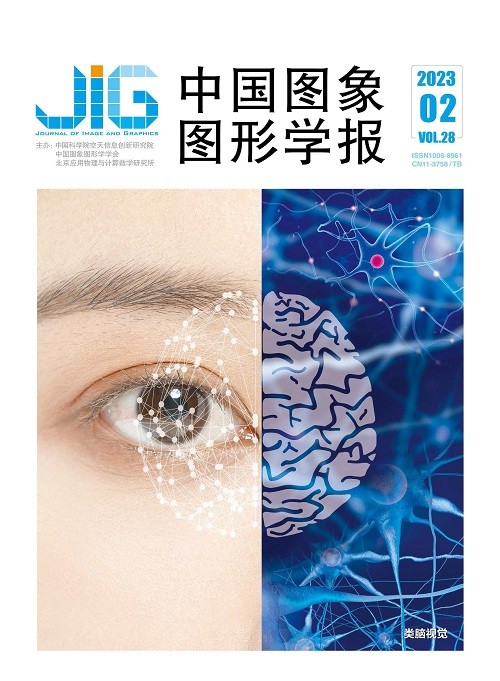
基于线性变换球面分布的实时间接光泽反射
夏博1,2, 刘艳丽1,2, 曾威1,2, 蒲一磊1,2, 张严辞1,2(1. 四川大学计算机学院, 成都 610065;2. 摘 要
目的 在实时渲染领域中,立即辐射度算法是用于实时模拟间接光泽反射效果的算法之一。基于立即辐射度的GGX SLC (stochastic light culling)算法中使用符合真实物理定律的GGX BRDF (bidirectional reflectance distribution function)光照模型计算间接光泽反射,计算复杂度很高,并且其计算开销会随着虚拟点光源的数量呈明显的线性增长。为解决上述问题,提出一种更高效的实时间接光泽反射渲染算法。方法 基于数学方法中的线性变换球面分布,将计算复杂度很高的GGX BRDF球面分布近似为一种计算复杂度较低的球面分布,并基于该球面分布提出了在单点光源以及多点光源环境下的基于物理的快速光照模型。该光照模型相比GGX BRDF光照模型具有更低的计算开销。然后基于该光照模型,提出实时间接光泽反射渲染算法,计算虚拟点光源对着色点的辐射强度,结合多点光源光照模型对着色点着色,高效地渲染间接光泽反射效果。结果 实验结果表明,改进后的实时间接光泽反射算法能够以更高的渲染效率实现与GGX SLC算法相似的渲染效果,渲染效率提升了20%~40%,并且场景中虚拟点光源数量越多,所提算法的效率提升越大。结论 基于线性变换球面分布的实时间接光泽反射算法,相比于GGX SLC算法,能够在不降低渲染效果的基础上,大幅提升间接光泽反射的渲染效率。
关键词
Real-time indirect glossy reflection based on linearly transformed spherical distributions
Xia Bo1,2, Liu Yanli1,2, Zeng Wei1,2, Pu Yilei1,2, Zhang Yanci1,2(1. College of Computer Science, Sichuan University, Chengdu 610065, China;2. Abstract
Objective Indirect glossy reflection effect (IGRE) can be as one of the commonly-used lighting effects nowadays. The IGRE-based simulation has been developing in related to designs of games, movies, animations, virtual reality and visual simulation. The IGRE can be employed to enhance image quality and is an essential part of the rendering in computer graphics. Current instant radiosity (IR) algorithm is beneficial to IGRE for real-time rendering. In order to calculate the glossy reflection effect (GRE) at the virtual point lights and the shading points, a certain lighting model is usually adopted to calculate the radiance of the ray-reflected like Blinn-Phong lighting model. In recent years, to calculate the IGR, IR-based GGX stochastic light culling algorithm (SLC) is focused on the GGX bidirectional reflectance distribution function (BRDF) lighting model further. However, the GGX BRDF lighting model has featured of high computational complexity, and it is time-consuming as well, including redundant trigonometric functions and square roots. Meanwhile, its computational overhead will increase dramatically in linear with the growth of the number of virtual point lights. To optimize the IGR effects, there are often hundreds of thousands or even millions of virtual point lights in the scene, which will cause very high shading overhead in the GGX SLC algorithm. But, the rendering performance is still ultimately challenged. So, we focus on the GGX SLC algorithm and carry out the analysis of the high overhead caused by the GGX SLC algorithm, which uses the GGX BRDF lighting model when rendering the IGR in detail. Our method is developed to improve the real-time IGR algorithm in terms of IR (i.e. GGX SLC algorithm). Method To lower the computational complexity of GGX BRDF spherical distribution, our research is concerned of the mutual-fitted issue of GGX BRDF spherical distribution with another spherical distribution based on linearly transformed spherical distribution. In this way, the goal of the GGX BRDF-simplified can be achieved. This spherical distribution to low computational complexity is melted into the point light source and a fast physics-based lighting model is obtained from single-point and multi-point light sources. This lighting model has a lower computational cost compared to the GGX BRDF lighting model. First, this fast lighting model is used to calculate the radiance of the virtual point lights and the shading points both. To improve its rendering efficiency, we implement a lighting model-based texture sampling strategy. Our algorithm has its potentials to improve the rendering efficiency of the indirect glossy reflection effect without the rendering quality loss. Result We conduct several experiments to verify that our real-time indirect glossy reflection algorithm. First, to validate the feasibility of our lighting model, our lighting model is compared to the GGX BRDF lighting model. The root mean squared error (RMSE) of our algorithm is less than 0.002. This indicates that our lighting model can achieve similar rendering quality to the GGX BRDF lighting model. Next, our algorithm is optimized and linked to improve rendering quality and rendering efficiency in different scenes. Our experiment results show that our rendering quality is very close to the GGX SLC algorithm (the RMSE is less than 0.006). The rendering efficiency can be increased up to 40% in the Sponza scene. The experiments are carried out on the effectiveness of the number of virtual point lights between the two algorithms mentioned above. The experimental results demonstrate that the efficiency of our algorithm can be improved more based on the number of virtual point lights-enlarged in the scene, while little loss in rendering quality compared with the GGX SLC algorithm. The RMSE is less than 0.003 while the rendering efficiency improvement can reach 30% in the metal ring scene. Conclusion A real-time indirect glossy reflection algorithm is developed in terms of linearly transformed spherical distribution. A lighting model with lower computational complexity is employed to optimize the GGX BRDF lighting model, which can reduce rendering overhead better. To alleviate the problem of texture sampling, a texture sampling scheme is optimized to improve rendering efficiency further. The experiment results demonstrate that our algorithm can improve the rendering efficiency of the indirect glossy reflection effect without sacrifice rendering quality potentially.
Keywords
real-time rendering instant radiosity indirect glossy reflection (IGR) bidirectional reflectance distribution function (BRDF) linearly transformed spherical distributions
|



 中国图象图形学报 │ 京ICP备05080539号-4 │ 本系统由
中国图象图形学报 │ 京ICP备05080539号-4 │ 本系统由